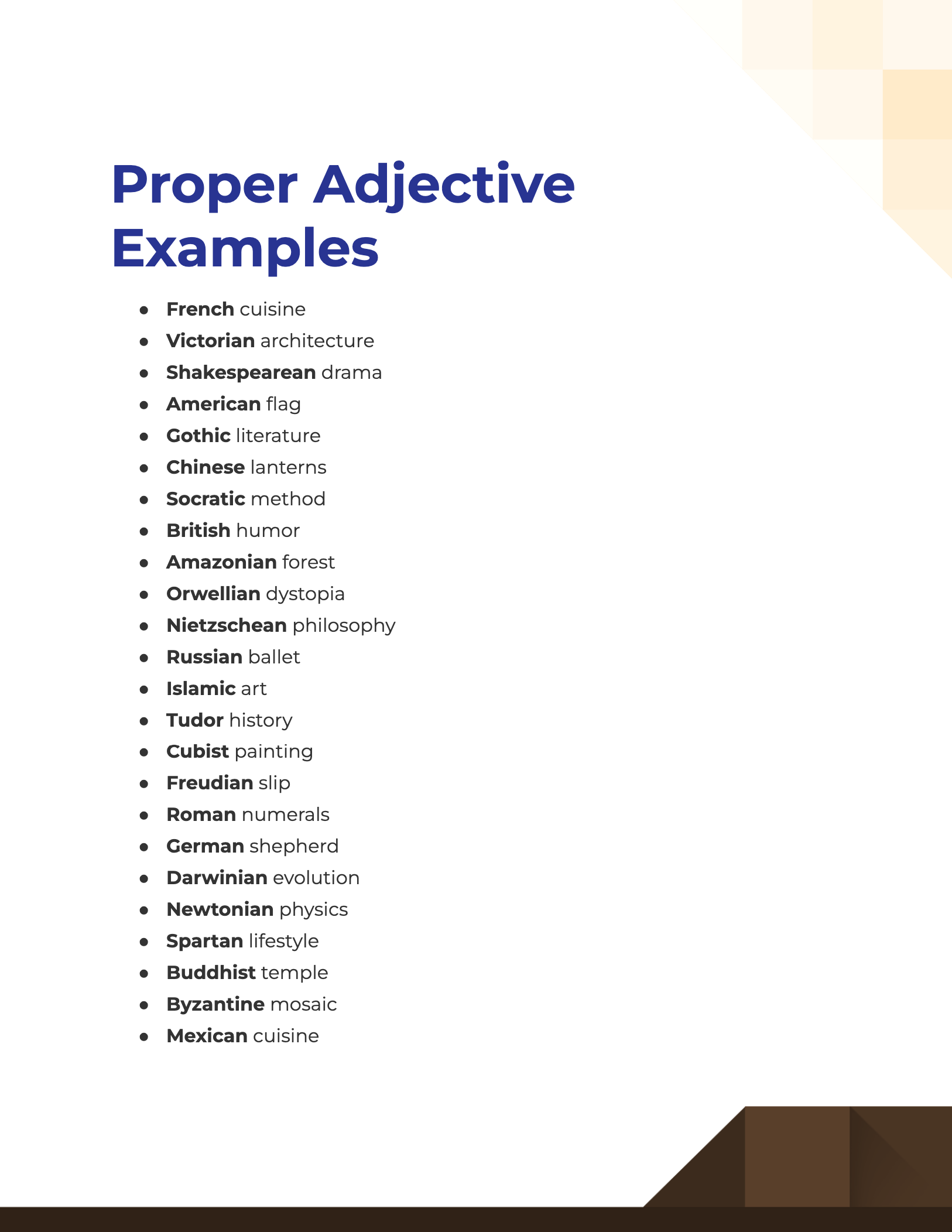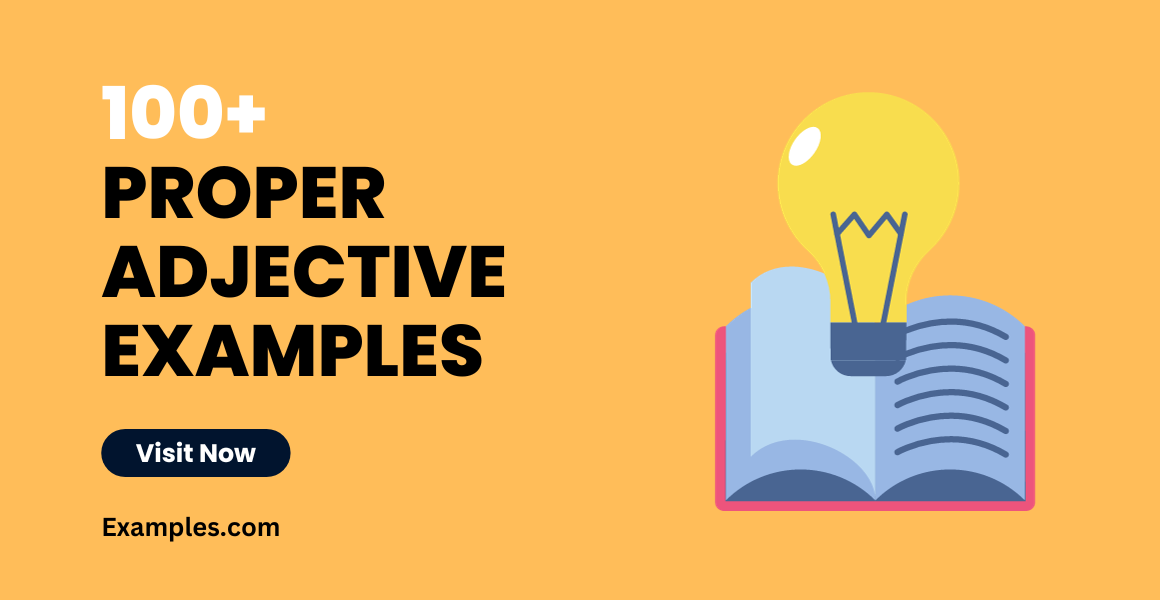99+ Proper Adjective Examples
Understanding Proper Adjectives is crucial for anyone striving to master the English language. Not only do they make sentences more engaging, but they also add specificity and color to your communication. From distinguishing types to decoding the best usage scenarios, this article is your one-stop guide for all things related to Proper Adjectives & adjective examples.
What is the Proper Adjective? – Definition
A Proper Adjective is an adjective that is derived from a proper noun and is usually capitalized. For instance, “American” comes from “America” and “Shakespearean” comes from “Shakespeare.”
What is the Best Example of a Proper Adjective?
The best example of a Proper Adjective would be ‘Elizabethan,’ derived from the name ‘Elizabeth,’ specifically Queen Elizabeth. In the sentence, “The Elizabethan era was marked by the flourishing of the arts,” the word ‘Elizabethan’ provides specific, enriched context to the era in discussion.
100 Proper Adjective Examples

A proper understanding of Proper Adjectives can make all the difference in your writing. These specialized adjectives add a layer of specificity that general adjectives can’t match. Read on to discover a plethora of examples that you can incorporate into your own writing, from academic essays to creative stories.
- French cuisine
- Victorian architecture
- Shakespearean drama
- American flag
- Gothic literature
- Chinese lanterns
- Socratic method
- British humor
- Amazonian forest
- Orwellian dystopia
- Nietzschean philosophy
- Russian ballet
- Islamic art
- Tudor history
- Cubist painting
- Freudian slip
- Roman numerals
- German shepherd
- Darwinian evolution
- Newtonian physics
- Spartan lifestyle
- Buddhist temple
- Byzantine mosaic
- Mexican cuisine
- Hollywood glamour
- Aristotelian logic
- Bohemian fashion
- Egyptian pyramids
- Georgian poetry
- Celtic knot
- Galilean moons
- Platonic friendship
- Olympian feats
- Kafkaesque situation
- Confucian ethics
- Edenic paradise
- Venetian blinds
- Homeric epic
- Vedic hymns
- Grecian urn
- Elizabethan sonnets
- Hermetic seal
- Draconian laws
- Michelangelesque sculpture
- Ptolemaic universe
- Christian values
- Jungian psychology
- Chomskyan linguistics
- Athenian democracy
- Machiavellian tactics
- Martian landscape
- Raphaelite art
- Platonic love
- Einsteinian relativity
- Nazarene teachings
- Renaissance painting
- Caribbean beaches
- Joycean novel
- Ciceronian oratory
- Tolstoyan narrative
- Adamic sin
- Sapphic verses
- Hemingwayesque prose
- Faulknerian complexity
- Vulcanian explosion
- Cartesian coordinates
- Dickensian poverty
- Sumerian myths
- Osirian mysteries
- Pyrrhic victory
- Promethean ambition
- Wagnerian opera
- Zen garden
- Copernican model
- Beatlesque melody
- Dylanesque lyrics
- Oedipal complex
- Napoleonic ambition
- Petrarchan sonnet
- Chaucerian tale
- Stentorian voice
- Miltonic verses
- Homeric similes
- Keatsian imagery
- Shavian wit
- Aesopian fable
- Epicurean delights
- Hobbesian state
- Dantesque Inferno
- Thomistic theology
- Voltairean satire
- Linnaean taxonomy
- Jeffersonian democracy
- Pythagorean theorem
- Euripidean drama
- Augustinian theology
- Sisyphean task
- Huxleyan dystopia
- Lockean philosophy
- Swiftian satire
What is a Proper Adjective Answer?
A Proper Adjective is an adjective derived from a proper noun, usually a place, person, or organization, and it is capitalized. The primary function of a proper adjective is to describe a noun by associating it with a particular quality linked to its origin. For example, in “French cuisine,” “French” is the proper adjective describing the noun “cuisine.” Learning to use proper adjectives accurately can add specificity and a layer of meaning to your writing, enriching it in ways that standard adjectives can’t.
What are the Exercises for Proper Adjectives?
Enhancing your understanding of proper adjectives isn’t difficult, but it does require consistent practice. Here are some exercises that can help:
- Identify the Proper Adjective: Read a paragraph and identify all the proper adjectives.
- Convert to Proper Adjective: Take a list of proper nouns and convert them into proper adjectives. For example, “America” becomes “American.”
- Fill in the Blanks: Have sentences with missing adjectives and fill them in with the correct proper adjective.
- Match the Pairs: Create a list of nouns and a separate list of proper adjectives. Match them appropriately.
- Write Sentences: Use given proper adjectives to write complete sentences.
- Multiple Choices: Choose the right proper adjective among the options provided to complete sentences.
- Synonym Search: Find synonyms for specific proper adjectives, understanding that sometimes the meaning might slightly change.
- Error Identification: Spot the error in sentences that misuse proper adjectives and correct them.
Doing these exercises regularly will help you become adept at using proper adjectives in your writing.
What is a Proper Adjective for Kids?
For children, a proper adjective is like a ‘name-word’ that helps describe something. Just like their names are special and start with a capital letter, some describing words also start with a capital letter. For instance, if a toy car is made in Germany, we can say it’s a “German toy car.” Here, “German” is a special describing word, or a proper adjective, and it tells us something unique about the toy car. Learning proper adjectives can be fun for kids, especially when associated with places or people they know. Worksheets, colorful flashcards, and interactive games can make the learning process engaging and entertaining for children.
Is Monday a Proper Adjective?
No, “Monday” is not a proper adjective; it is a proper noun. Proper nouns name specific entities and are capitalized, but they do not serve the role of modifying another noun. In the phrase “Monday meeting,” “Monday” serves as a noun adjunct or attributive noun, not as an adjective.
Is Tuesday a Proper Adjective?
Similar to “Monday,” “Tuesday” is also not a proper adjective. It is a proper noun. When used to describe another noun, like in “Tuesday afternoon,” it is functioning as an attributive noun rather than an adjective. While attributive nouns and adjectives can look similar in a sentence, they are different in terms of their grammatical function.
Is Beautiful a Proper Adjective?
No, “beautiful” is not a proper adjective; it is a common adjective. Common adjectives describe general qualities or attributes and are not derived from proper nouns. They are also not capitalized unless they start a sentence. “Beautiful” falls into this category, as it can describe any noun in a general sense, like a “beautiful painting” or a “beautiful song,” without relating to a specific origin or entity.
Proper Noun vs Proper Adjective
Proper nouns and proper adjectives often confuse people, but they serve distinct roles in sentences. A proper noun identifies a unique entity, such as “Paris” or “Shakespeare,” and is always capitalized. A proper adjective, on the other hand, is derived from a proper noun and modifies another noun. For example, “American” is a proper adjective derived from the proper noun “America.”
Key Differences:
- Origin: Proper adjectives are usually derived from proper nouns, while proper nouns are original identifiers.
- Function: Proper nouns act as subjects, objects, or object of prepositions in a sentence. Proper adjectives modify nouns.
- Capitalization: Both are capitalized, regardless of their placement in a sentence.
- Flexibility: Proper adjectives may change form (e.g., “English” becomes “Englishman”), but proper nouns stay the same unless they are being used in a different language context (e.g., “New York” may become “Nueva York” in Spanish).
How to Use a Proper Adjective? – Step by Step Guide
Understanding how to effectively use a proper adjective in your sentences can be a bit tricky but incredibly rewarding. These specialized adjectives, derived from proper nouns, add an extra layer of meaning and specificity to your writing. Here’s a more detailed step-by-step guide to ensure you’re making the most out of proper adjectives.
Step 1: Identify the Proper Noun
First and foremost, recognize the proper noun from which the adjective will be derived. For instance, if you want to describe something related to “China,” the proper adjective would be “Chinese.”
Step 2: Capitalize the Proper Adjective
Just like proper nouns, proper adjectives should always be capitalized, regardless of where they appear in the sentence. So it would be “Chinese” and not “chinese.”
Step 3: Determine Positioning
Proper adjectives usually precede the noun they modify. In some cases, they might come after the noun, but this is generally rare in English.
Example: The British museum is one of the best in the world.
Step 4: Check Agreement
In languages that require gender or plural agreement for adjectives, make sure your proper adjective aligns with the noun it modifies. This isn’t often a concern in English but is crucial for languages like French or Spanish.
Step 5: Avoid Use of Articles
Proper adjectives usually don’t take articles like “an,” “a,” or “the.” This is unlike proper nouns, which may or may not use articles based on the context.
Step 6: Sentence Check and Context Fit
After inserting the proper adjective, re-read your sentence to ensure that it flows well and that the adjective serves its purpose in highlighting or specifying the noun. Double-check the spelling, especially for adjectives derived from more complex proper nouns.
Step 7: Check for Redundancy
Make sure you’re not being redundant by using an additional adjective that the proper adjective already covers. For instance, saying “Italian Roma pizza” would be redundant as “Roma” already implies that the pizza is Italian.
Step 8: Global Understanding
Remember that proper adjectives might be specific to a particular country or region. If you are writing for a global audience, make sure that your proper adjective is universally understood or provide additional context to ensure clarity.
Step 9: Review and Revise
After you’ve finished writing, take a moment to review your usage of proper adjectives. Make sure they are consistently applied throughout your text and are adding, not detracting, from the overall readability and understanding of your writing.
By following these steps, you will not only improve the clarity and specificity of your writing but also engage your readers with more descriptive and informative sentences.
Tips for Using Proper Adjective
- Be Specific: Use a proper adjective when you need to specify the origin or some particular characteristic of the noun you are describing.
- Avoid Redundancy: Don’t use another adjective that conveys the same meaning as the proper adjective. For example, avoid saying “French Parisian café” as “Parisian” already implies that the café is French.
- Check Spelling: Always double-check the spelling, especially for proper adjectives derived from complex proper nouns.
- Test Fit: Sometimes a proper adjective can be too specific and may not be understood by a broader audience. Make sure it fits the context.
- Consistency: If you use a proper adjective, make sure you continue to use it in a consistent manner throughout your text.
By mastering the use of proper adjectives, you can enrich your language and make your writing more precise and engaging.



